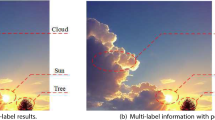Abstract.
Markov Random Fields, implemented for the analysis of remote sensing images, capture the natural spatial dependence between band wavelengths taken at each pixel, through a suitable adjacency relationship between pixels, to be defined a priori. In most cases several adjacency definitions seem viable and a model selection problem arises. A BIC-penalized Pseudo-Likelihood criterion is suggested which combines good distributional properties and computational feasibility for analysis of high spatial resolution hyperspectral images. Its performance is compared with that of the BIC-penalized Likelihood criterion for detecting spatial structures in a high spatial resolution hyperspectral image for the Lamar area in Yellowstone National Park.
Similar content being viewed by others
Author information
Authors and Affiliations
Additional information
Received: 9 March 2001 / Accepted: 2 August 2001
Rights and permissions
About this article
Cite this article
Lagona, F. Adjacency selection in Markov Random Fields for high spatial resolution hyperspectral data. J Geograph Syst 4, 53–68 (2002). https://doi.org/10.1007/s101090100074
Issue Date:
DOI: https://doi.org/10.1007/s101090100074




